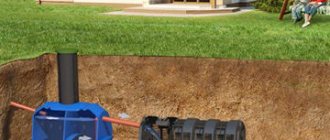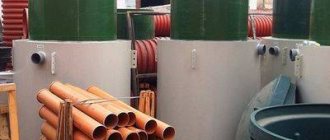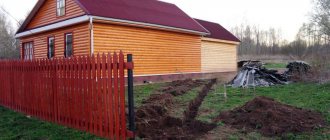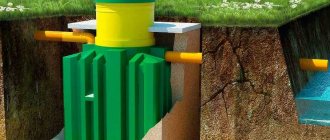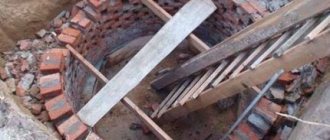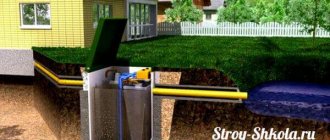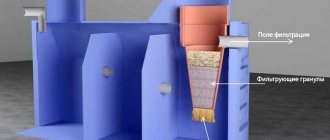The life of a modern person is filled with a variety of items that provide comfort and convenience. These include water supplied to the house, bathroom fixtures, and a toilet.
But such comfort systems, if they are not part of a general system, the presence of which is possible in urban apartment buildings, require an individual wastewater and waste treatment system. Previously, people made do with an ordinary sewage pit, from which the flowing masses were absorbed into the soil, and when they accumulated excessively, they cleaned the ditches with the help of special machines, or the pit was simply moved to another place.
The disadvantage of this method of getting rid of sewage was the saturation of the soil and even water wells with pathologically dangerous microorganisms, which, as a result, became the cause of many diseases in humans and animals. As well as contamination of the land and rendering it unsuitable for agricultural use.
In order to protect the earth and people from dangerous microorganisms, wastewater treatment systems were invented; our company has been installing such systems for many years.
The cheapest and easiest to install treatment option today is a septic tank, which is a complex single-section or multi-section structure that provides partial purification of wastewater and its absorption into the soil or partial drainage. At the same time, the septic tank provides for ground filtration, in which the liquid passes through layers of soil; this requires good drainage properties of the soil and a considerable field of drainage action.
Features of clays and loams
A septic tank for clay soil should have some design differences from conventional devices. To understand how a septic tank works in clay, you need to remember how conventional treatment plants work: first, the wastewater enters the sump, being divided into light and heavy fractions, and then the purified water enters the soil, where final purification occurs. To organize soil cleaning, filter wells are used, the design of which includes perforated walls and a drainage bottom. But the performance of such a system depends on several factors: laying depth, wall area, soil water level and the type of soil prevailing in the area.
The last indicator must be considered in more detail, since the efficiency of the entire structure depends on it. For example, one square meter of sandy soil can absorb about 90 liters of liquid per day.
In sandy loam soils this volume is reduced to 50 liters; loamy soils can process no more than 25 liters. In the case of dense clay soil, the situation is even worse: the soil can absorb more than 5 liters of water per day. That is why a septic tank on clay is constructed somewhat differently than conventional structures. You also need to know what to do if your septic tank stinks. There are many drugs and remedies to solve this problem.
Location of the well on the site and its size
When choosing the location of the filter well, you need to take into account that the standard distance between it and the foundation of any building should not be less than 10 m, and between it and the well, the water from which is intended for drinking, should not be less than 30 m. An important indicator is the groundwater level , which may limit the depth of the well. The minimum distance from the groundwater level to the bottom of the well should not be less than 1 m.
The size of the well is determined by the amount of wastewater and the type of soil. For example, a sandy loam with an area of 1 m2 can purify about 50 liters of water per day, and the same area of sandy soil can purify up to 100 liters. Based on such indicators and knowing the volume of wastewater, it is easy to calculate the required filtering area of the well, consisting of the sum of the areas of its walls. The plan area of the well should not be more than 2x2 m, and its depth should not be more than 2.5 m. For certain types of soil or for large houses, such a well is not enough - it simply will not cope with the given loads. In this case, you can install several filter wells, keeping a distance between them equal to two of their diameters.
Filtration in clay soil
As a rule, the layer of clay soil rarely has a thickness of more than 2-3 meters. This can be noticed when constructing a well: under the upper layers of the earth’s surface you will find sandy loam soils, or even clean sand, which has an excellent water absorption rate. In this case, the well will work much better than it could work in homogeneous soil: the water column will create high pressure.
When choosing a suitable solution, you should first study in detail the types of soil located on the site. You can find out from the old residents of the area, neighbors who have recently carried out construction work, or order a geological survey. The latter option will have maximum accuracy, and there is a point in studying the geology of the site: making a septic tank in clay is much easier and cheaper than purchasing a ready-made biological treatment station, which is only good for the most difficult situations.
Structurally, a septic tank on clay soil can be made in any way: you can install a plastic, brick, reinforced concrete or concrete system. Clay soil does not affect the choice of material at all, so this issue rests entirely on the shoulders of the homeowner, and depends on personal preferences and the amount of finance allocated for construction. Quite often, concrete rings for sewerage are installed with your own hands, which allows you to reduce costs.
Septic tank installation
The main problem at this stage is related to the fact that almost all clays (90%) belong to soils prone to frost heaving. It is because of this reason that the installation can be squeezed onto the surface, so it is necessary to resort to additional fastening of the local treatment plant during the installation process. Most often, a so-called bandage of steel strips or cables is used for this, which encircles the septic tank and is attached to the concrete base in the pit.
Considering that on clay soils, drainage systems (filtration fields) in many cases work only in the upper layers of the soil, it is necessary to resort to shallow installation of a septic tank.
In this case, it is necessary to provide measures for insulating the structure:
Insulating a septic tank with glass wool
- In the simplest case, they resort to pouring an additional layer of soil above the topography (forming a mound above the installation site of the septic tank).
- It is more effective to insulate the treatment plant with special heat-insulating materials, the choice of which is quite wide. The most affordable (in terms of cost) method is filling the container with expanded clay. The use of polystyrene foam (preferably extruded) or polyurethane foam is considered more effective. In addition, active protection systems against the effects of negative temperatures are increasingly being used. To do this, use a heating electric cable, the thermal power of which will reliably protect the septic tank from freezing even in harsh climatic conditions.
Watering
If there is good fertile black soil on the site, you can reuse water purified by a septic tank to water the plants.
To implement such a project, you will need to make the following design: the filter well must be replaced with a sealed tank to which a drainage pump is connected. This pump will supply purified liquid to the irrigation system. This septic tank design is well suited for summer cottages, but it is not practical to use it in country houses where people permanently live. Another disadvantage is the low degree of purification, as a result of which the treated wastewater has a characteristic sewer smell. To avoid this problem, you will have to use a septic tank with aeration.
When should you not make a filter well?
Finally, a few words about in what cases it is impossible to equip a filter well.
- Firstly, there is no point in building such a well on soils with low absorption capacity, for example, clayey ones.
- Secondly, the high level of groundwater will not make it possible to equip a well of the required volume in compliance with its design parameters.
In other cases, a filter well is perfect for the role of a septic tank and can be made independently without any problems.
Choosing a septic tank for installation on clay soil is a serious task, because the design must perform its functions efficiently and be able to purify wastewater from contamination. In addition, some designs allow the use of purified water in a second cycle. The implementation of such a project will be discussed in this article.
Filtration field
Sometimes even the densest soils demonstrate good absorption qualities. Of course, this does not always manifest itself, but if a soil analysis has shown that it can absorb at least a small amount of water, then you can take advantage of this and increase the absorption area. To implement this idea, filtration fields are used.
The structure is prepared as follows:
- first, the entire free area allocated for the structure is filled with crushed stone;
- then drains with holes of at least 2 cm in diameter are laid on it. The length of the pipeline in this case depends on the number of permanent residents: one person requires about 10 meters of pipe;
- then the pipeline is covered with at least a 10-centimeter layer of crushed stone;
- A layer of black soil is laid on top, on which moisture-loving plants can be planted.
This solution is quite convenient: in this case, little depends on the degree of wastewater treatment, because the smell will not be able to escape. In addition, if the depth of the pipes is more than 40 cm, then the sewer can be used even in winter, since the pipeline will not freeze. The disadvantage of the design is the impossibility of using it on soils that are completely impermeable to water.
Drainage device
Drainage system installation diagram.
Since such soil is not capable of good fluid permeability, a drainage system will be required to remove rain and flood water from the tanks for receiving sewage. To do this, not wall drainage, but ring drainage is performed. To install the pipeline you will need drains. You can use purchased perforated pipes or make them yourself from sewer plastic pipes with a diameter of 110 mm. Perforation is carried out with a drill 1.5-2 mm thick at a distance of 2-2.5 cm from each other. The holes should be staggered.
A trench is formed around the septic tank so that its bottom is 20-30 cm below the freezing point of the soil. Next, the bottom is leveled with a slope that should be at least 1 cm per 1 m towards the storage well. After this, they fill it with 5-7 cm of sand and 10-15 cm of gravel. Then geotextiles are laid on the bottom of the trench. A pipeline is installed inside the ditch and the pipes are wrapped with previously laid material. Then they begin backfilling.
Dumping into a ditch
In the case of soils that do not absorb moisture at all, you can dispose of wastewater directly onto the site or into a special ditch.
Naturally, such a system implies maximum wastewater purification (from 95%) and absence of odor. To implement the design, it is best to use energy-dependent septic tanks using aeration. Similar treatment plants operate on similar principles:
- the first tank constantly contains air, which supports the vital activity of aerobic bacteria that decompose organic substances entering the septic tank;
- Having passed the aeration stage, wastewater enters the next compartment, where the sludge sinks to the bottom and is transferred to the first container using a compressor;
- final purification is carried out in the third chamber, from which the purified water is pumped out and ends up in a ditch or large area from which it can evaporate.
Conclusion
As you can see from this article, a septic tank in clay soil is not a big problem.
The main thing is to correctly understand the characteristics of the site and choose the most suitable design that best suits the specific situation.
Management
To build a cesspool yourself in a private house, you need to make a lot of effort. If there is no bottom in the structure, you first need to lay small stones and gravel underneath, then fill everything with sand. This is necessary so that the drain liquid seeps into the ground, and the solid waste is treated by microorganisms. This type of latrine is environmentally safe. The waste pipe is mounted in such a container, with its outlet located below the soil freezing level.
If they decide to build a structure from concrete rings, the process becomes even more complicated. In addition to all the previous steps, it is also necessary to make a concrete screed around the perimeter of the pit, on which the lower ring will be installed. Then several holes must be drilled in this reinforced concrete product. After installing the rings, a plate containing holes for pumping and supplying the drain pipe must be installed on the top of them.
The event is much simpler if you need to install a ready-made Maple septic tank on the site. Installation of a structure completely ready for further operation involves performing the following actions:
- pit preparation;
- placement on a sand cushion;
- fastening of waste pipes;
- burying the entire underground structure.
